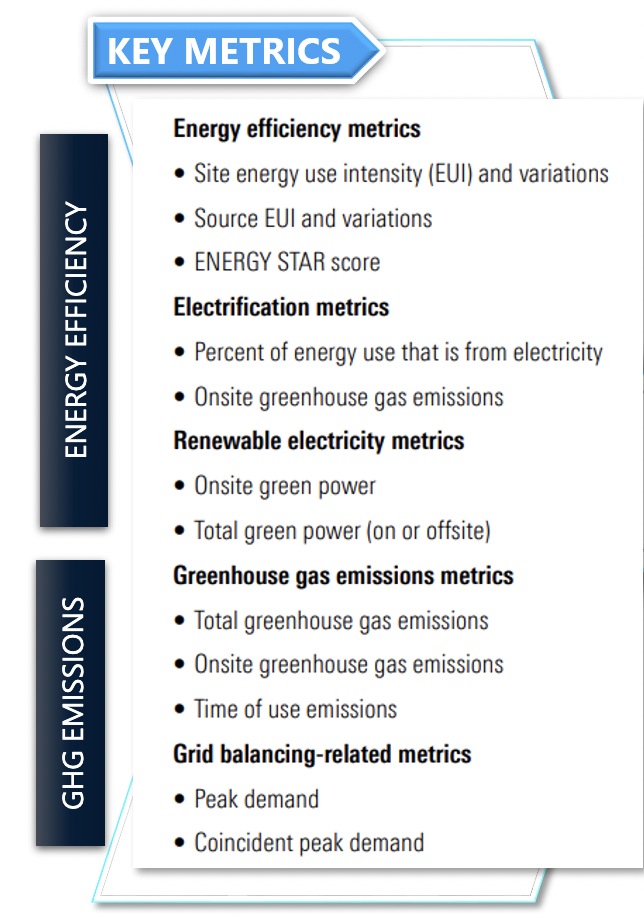Defining Characteristics of BPS:
–> Performance Target: either in terms of on-site energy use intensity (EUI) or annual greenhouse gas emissions— for each building type (e.g. one target for offices, another target for multifamily, etc.).
–> Timeframes: Buildings subject to these policies have a set number of years, referred to as a cycle, in which to comply – with increasingly stringent interim targets in subsequent years. As the policy ages and new jurisdictional climate goals are identified, additional buildings may be included. This phase in approach allows ample flexibility for buildings to improve over time and discourages long-lived investments in inefficient and environmentally damaging technology.
Benchmarking:
While BPS and benchmarking ordinances are each distinct policies, benchmarking requirements are a meaningful bedrock to an effective BPS or other efforts to improve energy performance whether voluntary or mandatory. In fact, the data collected through measuring and assessing energy performance for benchmarking by corporations often helps state and local governments to set and measure compliance with a BPS, making benchmarking an excellent place to start for corporations preparing to comply with BPS laws now or in the future. Jurisdictions where benchmarking policies are in place require building owners to measure, report, and disclose building energy use, however, benchmarking can also be conducted voluntarily by any property owners to reap the benefits of peer comparison.
Benchmarking policies typically use EPA’s Energy Star Portfolio Manager tool. Portfolio Manager is an interactive resource management tool that enables you to benchmark the energy use of any type of building, all in a secure online environment. Nearly 25% of U.S. commercial building space is already actively benchmarking in Portfolio Manager, making it the industry-leading benchmarking tool.
Data Collection Processes:
Reaching these BPS performance targets will require addressing energy use and emissions in new and existing buildings through retrofits and operational strategies, and that begins with the foundation of data collection.
- Questions to ask when getting started:
- Requirements and Policy Impacts: What are the Specific Performance targets relative to my properties? (based on the type of real estate and size) How will compliance affect building operations and cost?
- Policy Schedule: What is the compliance timeline and how will my data collection timeline need to align accordingly?
- When do I need to start making building upgrades?
- Is benchmarking data available for access that will allow me to view the progress of my peers and similar building types to determine what data they track?
- Capture the Baseline: Utility data access is not just a matter of convenience for building owners, but rather a fundamental requirement for owners to be able to comply with benchmarking requirements and work with tenants on data collection. Baselining your facilities requires analyzing historical utility invoice data and interval meter data for a detailed understanding of your facilities’ energy consumption and environmental impact. Refer to this resource from the EPA to understand more about metering.
- Know the key data metrics you need to track:
- Additional information to monitor for holistic building management:
- Capital Plans
- Due diligence checklists
- Performance-based leases
- Performance specs for new construction
- Job descriptions and evaluation for property managers and building engineers
- Benchmarking: The first step to saving energy at your building is to benchmark — that is, to measure and compare your building’s energy to similar buildings, past consumption, or a reference performance level. benchmarking is useful to measure and track other important sustainability KPIs such as water use, waste, and greenhouse gas emissions.
- Tracking Retrofits: Retrofit measures should be more intensively integrated into long-term budgeting and investment planning. Consequently, the associated emissions should also be clear and included in the forecasts. Being aware of the ecological impact of the retrofits and possible intervention points for significant reduction ensures the allocation of necessary financial resources and balancing environmental goals with economic considerations. Understanding ROI from retrofits through measurement and verification procedures is also crucial to ensuring the long term viability of compliance plans for BPS.
- Goal Setting: Sustainability goals are integral to BPS compliance. Create and track sustainability goals over time using WatchWire’s goal-tracking feature to monitor your corporation’s sustainability performance and track progress in relation to anticipated BPS deadlines.
- Operationalizing Data for Continuous Insight: Leveraging technology is crucial in data management for BPS compliance. Integrating energy and sustainability management software like WatchWire with your utility bills and installing Energy Star meters to help streamline data collection can ultimately provide real-time data insights and ensure accessibility across functional roles in the long run.
- Lease Management: Leases are critical to incentivizing both tenants and landlords to reduce energy use and improve building performance in order to comply with BPS laws. Performance-based leasing builds upon collaborative strategies in green leases to further clarify the landlord-tenant relationship in addressing building performance as it relates to potential building performance standards or regulatory compliance needs. Gathering lease data is crucial in establishing who is the sustainability point of contact, evaluating current agreements between tenants and landlords, enabling collaboration and sharing responsibility, and establishing legal clarity and incentives. Traditional leases also lock in insufficient practices, such as heating or cooling buildings even when vacancy drops dramatically, as seen in the discrepancy between occupancy rates and decreases in energy use during the COVID-19 global pandemic
- Space Management Data: Understanding utilization & occupancy rates, overall building costs, and work orders can greatly enable your facilities to implement energy efficiency measures and savings.
What to look for in an energy and sustainability data management software
It will be very difficult to comply with looming building performance standards and associated benchmarking ordinances without using unifying technology and a platform that facilitates the collection of energy and utility data, calculates carbon metrics, and reports investor-grade data within multiple areas, ready for audit scrutiny. WatchWire can help support the needs of property owners across all industries in their endeavors to decarbonize and retrofit their buildings and report on their progress. Facility managers and building owners have traditionally relied upon scheduled maintenance and planned operating schedules with little to no visibility into how energy-intensive equipment is performing on an ongoing basis across their sites. Sustainability managers or hired consultants may also employ the use of error-prone manual entry spreadsheets to complete emissions inventories, carbon accounting, and energy usage reports. Automated data capture and AI monitoring systems used to track and analyze the energy use, sustainability metrics, and efficiency projects of an organization will eliminate the liability risk and productivity loss associated with older methods of calculation and operations.
Features to aid in compliance:
- Remote monitoring & diagnostics: detect and diagnose instances of energy waste and equipment faults in your portfolio with real-time monitoring
- Automated, cloud-based data capture & storage
- Energy and utility management baseline
- Emissions calculations and inventory: Automate data acquisition, track GHG emissions based on the GHG protocol, maintain and update custom emissions factors, allow customization where desired such as with scope 2 market-based (or location-based) factors, on demand carbon inventory
- Decarbonization Planning: Help with renewable energy procurement, and track onsite DERs (e.g. solar), RECs, and offsets within our system.
- Goal Tracking: Track Progress toward net zero & and emissions reduction targets. Add absolute or intensity metrics with predetermined benchmarks or KPIs, track monthly or annually, add baselines and target year, real time monitoring
- Comprehensively track sustainability metrics: energy consumption, emissions data & and accounting, water use, waste generation, renewables, space, budgets, and ownership
- Guidance on compliance with local laws, ordinances, and building codes for green buildings and emissions reduction targets
- Data auditing and assurance built in
- M&V: M&V is a process for quantifying the precise impact on energy use of a conservation measure. It puts numbers into a difficult-to-quantify process and makes it easy to deploy efficiency measures, verify your emissions reductions efforts, and calculate the dollar impact for savings of an investment.
- Compare building performance with performance benchmarking across your portfolio and against peers, and organize metrics based on geographic region, accounts, meters, and more
- Sustainability reporting integrations: Compatible integrations with main reporting schemas, advice on reporting, and customizable financial grade report generation. As one of the most active ENERGY STAR service providers in the industry, WatchWire has a bi-directional integration with Portfolio Manager. We push and pull data to and from Portfolio Manager to automate reporting and compliance!
- BPS Compliance Partnerships: Recently, WatchWire became a booster partner of the Institute for Market Transformation (IMT), meaning that our platform will provide programmatic identification of benchmarking and building performance standard policies that apply to each building across your portfolio. WatchWire users can then assess compliance pathways, potential penalties, or potentially stranded assets.
WatchWire by Tango is a market-leading, energy and sustainability data management platform that uses cloud-based software to collect, automize, and analyze utility, energy, and sustainability data metrics. WatchWire streamlines, automates, and standardizes your sustainability reporting process by integrating directly and/or providing reporting exports to ENERGY STAR Portfolio Manager, LEED Arc, GRESB, CDP, SASB, GRI, and more. The platform provides customizable dashboards, which allow asset managers, sustainability managers, engineers, and more to monitor individual key performance indicators (KPIs) and create custom views for specific use cases.
To discover more about WatchWire and its capabilities, you can visit our website, blog, or resource library, request a demo, or follow us on LinkedIn, Instagram, or Twitter to keep up-to-date on the latest energy and sustainability insights, news, and resources.
 Top Sustainability Trends to Watch in 2025
Top Sustainability Trends to Watch in 2025

 Log In
Log In










